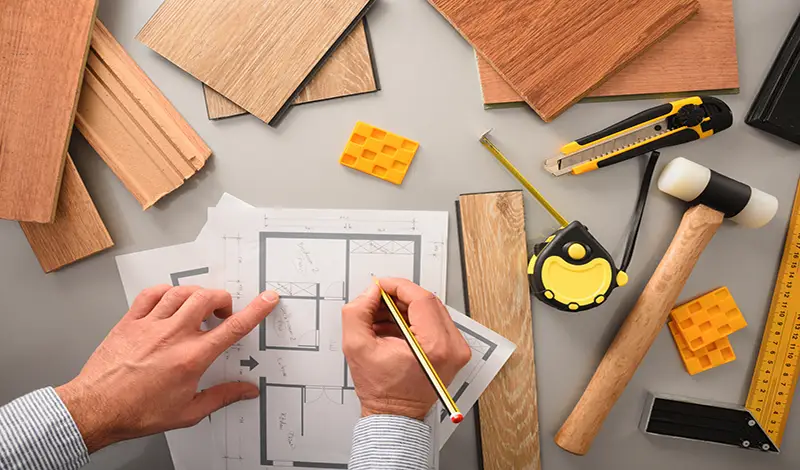What is a Home Renovation Loan?
Published on May 13, 2024 | 5 Minute read

Melanie
Ortiz Reyes
Content Specialist
Dreaming of transforming your current home into your ideal living space? Whether it’s updating a dated kitchen, adding an extra bedroom, or creating a cozy backyard oasis, home renovation projects can breathe new life into your property and enhance its value. However, financing these projects can be a significant hurdle for many homeowners. This is where home renovation loans come into play, offering tailored financial solutions to turn your renovation dreams into reality.
What is a Home Renovation Loan?
A home renovation loan is a type of financing specifically designed to fund home improvement and renovation projects. Unlike traditional mortgages or personal loans, which may have limitations on using funds for renovations, home renovation loans provide dedicated funds for upgrading, repairing, or expanding your home.

How Do Home Renovation Loans Work?
Home renovation loans work by providing borrowers with funds upfront based on the estimated cost of their renovation project. The loan amount may cover labor costs, materials, permits, and other expenses directly related to the renovation. Borrowers typically repay the loan over time through regular installments, similar to a mortgage or personal loan.
Types of Home Renovation Loans
a. Home Equity Loans: These loans allow homeowners to borrow against the equity in their home. They provide a lump sum upfront, often at a fixed interest rate, and the loan is repaid over a specified term.
b. Home Equity Lines of Credit (HELOCs): Similar to home equity loans, HELOCs also leverage home equity but provide a revolving line of credit that borrowers can access as needed. Interest rates may be variable, and borrowers only pay interest on the amount borrowed.
c. FHA 203(k) Loans: Backed by the Federal Housing Administration (FHA), these loans are designed for purchasing or refinancing a home in need of repairs or renovations. They combine the cost of the home and renovation expenses into a single loan, making them attractive for buyers seeking fixer-upper properties.
d. Personal Loans for Home Improvement: Unsecured personal loans can also be used for home renovations, offering flexibility and quick access to funds without leveraging home equity. However, interest rates may be higher compared to secured loans.

Benefits of Home Renovation Loans
a. Access to Funds: Renovation loans provide homeowners with the necessary funds to complete projects without draining savings or disrupting other financial goals.
b. Increased Property Value: Well-planned renovations can increase the market value of your home, potentially leading to higher resale value or improved equity.
c. Flexible Repayment Options: Depending on the type of loan, borrowers may have flexible repayment terms, interest rates, and access to funds as needed throughout the project.
d. Tax Benefits: In some cases, the interest paid on home equity loans or HELOCs used for home improvements may be tax-deductible. Consult with a tax advisor for specific guidelines.
Eligibility and Considerations
a. Credit Score: Lenders typically consider credit scores when approving renovation loans. A higher credit score may result in better loan terms and interest rates.
b. Equity and Loan-to-Value Ratio: For home equity loans or HELOCs, lenders assess the amount of equity in your home and the loan-to-value ratio to determine loan amounts and terms.
c. Loan Amounts: The loan amount you qualify for depends on factors such as the scope of renovations, appraised home value, and lender guidelines.
d. Documentation: Prepare documentation such as renovation plans, cost estimates, income verification, and credit history for loan applications.

Tips for Leveraging Home Renovation Loans
a. Plan Your Renovation: Develop a detailed renovation plan outlining project scope, timelines, and budget estimates to ensure you borrow an appropriate amount.
b. Compare Loan Options: Research and compare loan options, interest rates, fees, repayment terms, and eligibility requirements from multiple lenders to find the best fit for your needs.
c. Work with Reliable Contractors: Hire experienced and licensed contractors for renovation projects to ensure quality workmanship and adherence to timelines and budget.
d. Budget Wisely: Allocate funds wisely across renovation aspects such as materials, labor, permits, and unexpected contingencies to avoid cost overruns.
e. Keep Resale Value in Mind: Consider renovations that add value to your home and appeal to potential buyers if resale is a future consideration.
Navigating the Renovation Journey
a. Initial Planning: Define renovation goals, budget constraints, and desired outcomes. Consult with design professionals or contractors for insights and cost estimates.
b. Financial Assessment: Evaluate your financial situation, explore loan options, and determine affordability and repayment plans that align with your budget.
c. Loan Approval and Execution: Complete loan applications, gather required documentation, secure loan approval, and establish timelines for accessing funds and initiating renovations.
d. Project Management: Coordinate with contractors, monitor progress, address any issues promptly, and stay within budget and timelines for a successful renovation experience.
e. Completion and Enjoyment: Upon project completion, review the work, ensure quality standards are met, and enjoy your newly renovated space with family and friends.
Home renovation loans offer a valuable financial resource for homeowners looking to enhance their living spaces, increase property value, and achieve renovation goals. By understanding the types of loans available, eligibility criteria, benefits, considerations, and leveraging tips, homeowners can navigate the renovation journey with confidence, creativity, and financial prudence. Whether it’s a small kitchen upgrade or a full-scale home transformation, renovation loans pave the way for turning dreams into reality and creating the perfect home environment tailored to your lifestyle and preferences.